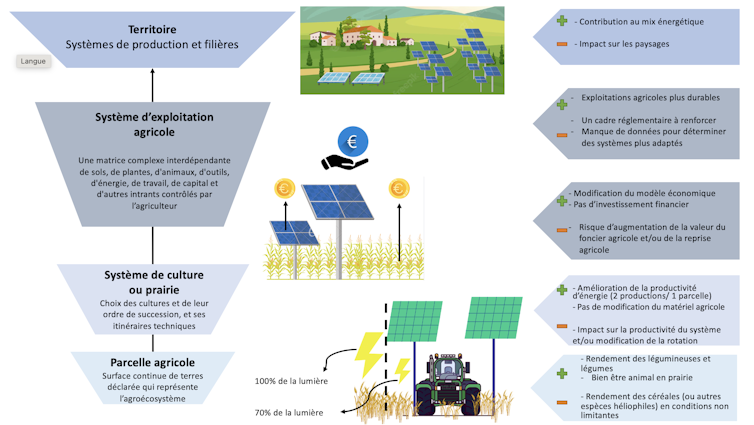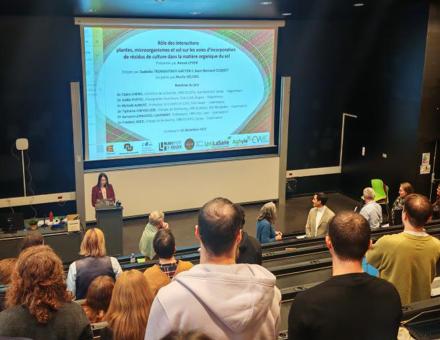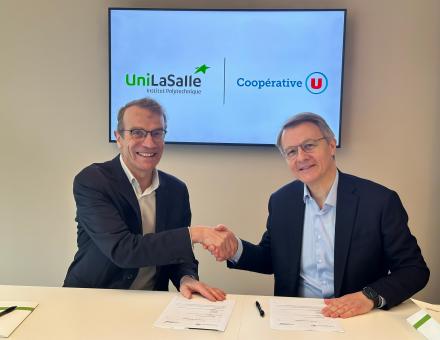Discover the new article by Michel-Pierre Faucon, Marc Legras and Romain Gloaguen, respectively in Plant Ecology and Agroecology & Director of Research at UniLaSalle Beauvais, Director of Training at UniLaSalle Rouen, and Teacher-Researcher in Agronomy for The Conversation.
In recent years, we have heard more and more about "agrivoltaics", of which the Ademe lists about 200 projects underway in France. A regulatory and legislative framework has also recently been adopted for this emerging sector.
An agrivoltaic system corresponds to the association of solar panels and a crop, without inducing any significant degradation of agricultural production or reduction in income from this production; it also supports the adaptation of cropping systems to climate change (protection or mitigation of hazards such as hail, heat, drought or improved animal welfare).
A study published in the journal Nature estimates that if 1% of the surface area used for agriculture were combined with photovoltaic production, the entire global demand for electricity would be covered.
Even if it allows a high productivity of energy, agrivoltaics raises many questions, especially those related to the agronomic model of farms, as well as their economic model and their land capacity. It is to these aspects that we will focus.
We will therefore leave aside questions about the landscape impact and the perceptions of local residents with regard to these new farms (in particular the visual disturbances generated and their potential consequences on the value of the land). These perceptions vary according to the facilities (such as the planting of hedges around the installations) and the understanding of the inhabitants of the sustainable energy mix to meet their needs and reduce greenhouse gas emissions.
Contrasting effects on agricultural production
Today, there are three types of agrivoltaic systems.
Structures composed of rows of solar panels close to the ground, with cultivable spaces between the rows to accommodate agricultural equipment. Photovoltaic structures close to the ground, associated with livestock or aquaculture (with floating panels). Elevated structures that allow access for farm equipment under the PV plants - this is the most expensive configuration, but also the most appropriate to limit the impact on agricultural production.
The installation of agrivoltaic systems affects the solar radiation, temperature and humidity of the soil under the panels. The decrease in received radiation appears to be the major factor impacting the performance of agricultural crops, being on average 30% lower under agrivoltaic plants.
The yield of some crops (cereals) tends to decrease while others (legumes, raspberries) have a better yield potential due to these shaded conditions.
In general, it can be said that sun-loving annual crops (especially cereals) grown under agrivoltaic plants have lower yields, but better growth in hot weather.
Diagram showing the impacts of agrivoltaics. Julie Pilloy,
CC BY-NC-ND
On which agricultural plots should it be installed?
Faced with the increasing frequency of climatic hazards inducing thermal and hydric stress, agrivoltaics could be positive for a better resistance or resilience of crops.
The density and percentage of ground cover (i.e., the percentage of soil covered) of solar panels should be defined according to the potential yield losses for years without climatic hazards (without stressful conditions for the plants; for example, without hail or drought) in order to manage this risk.
Fertile soils with high yield potential (such as the deep silt-rich soils of the plateaus and valleys of northwestern Europe) would not be the most suitable for the installation of photovoltaic power plants, since they could lead to a decrease in the production of crops that need a lot of light. The challenge is therefore to identify the best crop-photovoltaic panel associations and to define the most appropriate cropping systems and territories (with regard to their soil and climate) for agrivoltaics.
For the areas of breeding in grassland, the implementation of raised solar panels is interesting, especially in summer. Indeed, the installations do not seem to impact grass production and contribute to the well-being of the animals by reducing thermal stress (the animals benefit from shaded areas).
What are the impacts on biodiversity?
The installation of solar power plants can change the soil properties at the scale of the agricultural plot, and thus the local biodiversity in the short and long term (but not necessarily negatively). Environmental impact studies are therefore necessary to ensure a balance between biodiversity conservation and the expansion of solar power plants.
Land artificialisation by renewable energy installations is also an important issue.
Currently, French legislation considers that farms affected by an agrivoltaic installation are not counted "in the consumption of natural, agricultural and forest areas as long as the modalities of this installation do not durably affect the ecological functions of the soil".
This can be explained by specific installation and dismantling techniques that would not irreversibly modify the initial vocation of the land and the functions of the soil.
Constraints and levers at the farm level
Agrivoltaics is a form of diversification of activities for farmers that can be sustainable, especially for production systems for which the additional shading of the panels is beneficial, such as market gardening or permanent grassland systems.
An economic study of agrivoltaic systems has shown that the value of electricity generated by solar energy, coupled with the production of shade-tolerant crops, generates an increase of more than 30% compared to conventional farms.
Compared to crops dedicated to the production of biofuels (rapeseed, beets), it proves to be more productive (x 10 in terms of energy produced per hectare) and impacting in the reduction of GHG emissions, as bioenergy crops require synthetic chemical fertilizers (100 to 200 units of nitrogen per hectare) and several stages of transformation.
The implementation of agrivoltaics can also be a lever in the indirect reduction of greenhouse gas (GHG) emissions, by balancing the consumption of fossil energy, through self-consumption of electricity and a reduction of GHG emissions by the amount of energy produced on a farm. Agrivoltaics would also be an opportunity for farms, which consume more electrical energy and emit more GHGs.
Risks of speculation
Regulated agrivoltaics, reconciling agricultural production and electricity production and securing the rural lease between the landowner and the farmer, would reduce the risk of developing photovoltaic power plants that consume agricultural land.
However, the rent paid by energy companies in exchange for solar installations can be ten times higher than what the land rental to a farmer can bring (the farm rent). This attractiveness can lead to speculation and an increase in the value of the land and/or the farm. The reduction of this risk, recently framed by the AER law, requires the definition of an organizational mode between the investor, the owner and the farmer.
What future for agrivoltaics?
Although agrivoltaics is generating a certain amount of interest, it is necessary to remember that the priority of photovoltaics remains the development of wastelands and economic activity zones whose soils have largely been artificialized.
Agrivoltaics can find its place in rural areas with regard to the biofuel industry (wheat and beet ethanol, rapeseed diester), which consumes agricultural land (more than one million hectares in France), energy and emits more GHGs, and which has other uses, such as powering the heat engines of heavy machinery (for construction, certain agricultural works, transport, etc.) that are difficult to replace with electric motors.
The agrivoltaic industry must therefore be structured in such a way as to ensure that agriculture's primary vocation (producing food) is maintained. To do this, it can rely on the "agrivoltaic project" label created by Afnor, the guide to agrivoltaics applied to ruminant breeding by Idele, and the development of research work carried out with a variety of actors (energy specialists, advisors, farmers and residents).The Conversation
Michel-Pierre Faucon, associate professor in plant ecology and agroecology - Director of Research, UniLaSalle Beauvais, UniLaSalle; Marc Legras, Director of Training - UniLaSalle, UniLaSalle and Romain Gloaguen, associate professor in Agronomy, UniLaSalle
This article is republished from The Conversation under a Creative Commons license. Read the original article.







